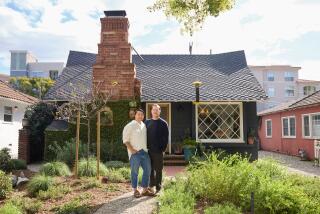Shady Characters : Shedding Light on the Problem of Darkness in the Garden
ALL GARDENS have what seem to be impossible places: too dark, too small, or both. This tiny sliver of land on Lido Isle in Newport Bay seldom sees the sun and is too narrow for any grand scheme, but it proves that almost any space has potential.
This is not a dark location, such as under a dense tree, which is a shade more difficult. Here, a substantial patch of open sky (but no direct sun) gives enough light to grow a number of things. And the plants chosen here are among the best for shady places.
The basic ground covering, baby’s tears, grows where few other ground covers can. Even in dense shade it is an aggressive spreader. Poking out of the sea of baby’s tears are two companions that can successfully compete with it. Impatiens add nearly year-round flowers to the scheme; bronze-leaved ajuga supplies handsome, contrasting foliage (and short blue spires in spring). The ajuga is important to the design, breaking up the green monotony and seeming to point the way to the mailbox.
The shrub with the maple-like leaves is an abutilon, also tolerant of shade and capable of outgrowing this spot. However, Roger’s Gardens Colorscape in Corona del Mar, designers of this slice of garden, has found that abutilons can be pruned to practically nothing and rebound in a few months time, looking all the better for it.
The Boston ivy, clinging to the wall, will grow in complete shade. It can, in fact, completely cover the side of a house and must be pruned away from windows and doors. It is one of the few vines that attaches itself, clinging with little suckers that stay attached, even when the vine is removed from the wall. But as compensation for that annoyance, the ivy becomes a hedge-like wall of green that turns orange and red in the fall just before the leaves drop. Even after that--in winter--it makes a fine tracery against the wall, adding dimension to the design.






